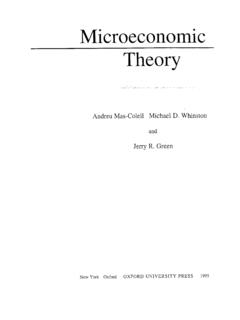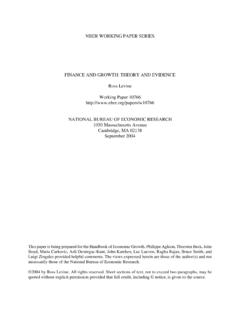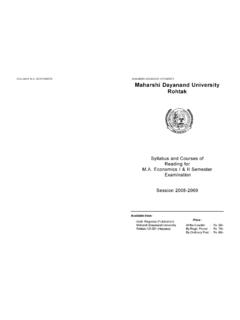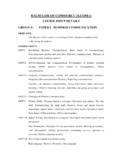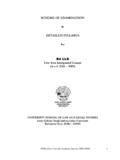Transcription of UNEMPLOYMENT: A REVIEW OF THE EVIDENCE …
1 OECD Economic Studies No. 20. Spring 1993. unemployment : A REVIEW OF THE EVIDENCE . frqm PANEL data .. Peder J Pedersen and Nieis Westergird-Nielsen CONTENTS. Introduction .. 66. 1. Survey of empirical results .. 67. A. Individual background factors .. 70. B. Training and labour market programmes .. 72. C. History dependence .. 75. D. Insurance effects .. 78. E. Job offer arrival rates and acceptance probabilities .. 83. F. Adaptation of reservation wages .. 84. G. Temporary layoffs and experience'rating .. 85. H. Demand factors .. 86. 1. Other factors .. 86. II. Concluding remarks .. 87.
2 Bibliography .. 91. Annex 7: Tables A1 and A2 .. 99. Annex 2: Individual labour market data .. 111. This paper is based on material prepared for the OECD in consultation with the Resource Allocation Division of the Economics Department. The authors are both from the Centre for Labour Economics. University of Aarhus and the Aarhus School of Business. They would like to thank Jsrgen Elmeskov. Karl Pichelmann and Peter Sturm for their helpful comments on earlier drafts . INTRODUCTION. The continued high unemployment in western Europe and North America has given rise to a discussion of the reasons for this persistence of unemployment .
3 One hypothesis is that persistence is due to the depreciation of human capital in case of longer spells of unemployment . Another explanation discussed in the literature is a shortage of real capital due to longer periods of unemployment with a low level of investment activity. Insider-outsider theories for the determination of wages have also been used to analyse the labour market reaction to negative shocks, resulting in an increased number of outsiders without influence on the determination of wages. Other attempts to explain persistence concentrate on the impact from incentives in the unem- ployment insurance system on the behaviour of workers.
4 On the employers' side of the market, rules about redundancy payments and other costs related to layoffs of workers can create incentives working against a reduction of unemployment . Finally, an obvious contribution in explaining the persistence of high unemployment , especially in Europe, comes from the demand side. The importance of demand, at least in the short to medium term, should be kept in mind when interpreting the results from the microeconomic studies surveyed below. Discussions of these hypotheses are usually founded in aggregate data and are not particularly detailed when it comes to the underlying microeconomic model.
5 How- ever, it should be possible to discriminate with greater certainty between competing theories by using micro data . A substantial growth in micro data sets in recent years in most OECD countries have spurred a number of empirical studies drawing on micro EVIDENCE . The purpose of this paper is to survey the results from a number of microeconomic studies using panel data , and investigate if a common trend can be deduced from the results, that may be used for policy recommendations and as a guideline for further research. The major part of empirical studies using panel data have appeared during the last 10-15 years.
6 The statistical and econometric methods necessary to obtain reliable estimates have been developed during this period, and by their very nature, time is necessary to build sets of panel data . Time alone is a necessary, but not sufficient, condition for building a longitudinal database. Along with the development of econometric methods, the necessary skills had to be developed with respect to admin- istration and handling of data sets that are typically much bigger and more complex than the aggregate time series data used in much empirical work in economics. Finally, many factors, including costs of data collection and the delicate problems related to data confidentiality, have in many cases made it necessary to utilise the data sets researchers have been able to construct - or collect from different sources, instead of the optimal data sets (discussed below).
7 Further details on the various types of labour market data are provided in Annex 2, which discusses in particular the characteristics of micro and panel data . Some of the key terms and concepts used in panel data studies are summarised in the Box. Section I provides the survey of empirical results. This survey is organised into several main areas, which are set out at the beginning of the section. Some concluding comments are provided in Section II. The studies surveyed are presented in a more compact way in the Tables A1 and A2 in Annex 1. 1. SURVEY OF EMPIRICAL RESULTS. The present section does not attempt to give a complete survey of all panel studies in every OECD country completed during the last 10-15 years.
8 Instead we shall try to summarise a number of recent studies with respect to the nature of data used, the motivation of the studies, estimation methods and the main results. The studies have been selected with the purpose of giving a balanced representation among countries, types of data sets, hypotheses examined, and estimation methods. With few excep- tions only studies using data covering individual behaviour have been selected. The studies selected for REVIEW cover the United States, the United Kingdom, Australia, Canada, Germany, the Netherlands, Austria, France, Belgium, Sweden, Denmark and Finland, with the majority of the studies using US.
9 data . Inter-country comparisons are difficult, however: there are institutional differences between countries - for example in unemployment insurance arrangements; differences in data sets ( sample sizes); and, despite the wide use of the hazard function approach, there are differences in specifications of functions and in whether unobserved heterogeneity is accounted for. The survey of the results from the included studies are organised into some main groups. The first group consists of results concerning the importance of individual background factors for the probability of becoming unemployed, of being hit repeatedly by unemployment , and of escaping from unemployment either to a regular job, to a state outside the labour force, or to participation in some labour market programme.
10 The individual background factors can be viewed both as instruments to control for individual heterogeneity and as indicators for targeting of policy instruments. The second group of results summarises conclusions relative to individual history dependence, especially in relation to unemployment . The majority of studies presents results on duration dependence, the impact on the escape rate out of unemploy- ment from the time spent in unemployment . A number of studies present resuits also on lagged duration dependence and on occurrence dependence, the phenomenon of recurrent unemployment .











